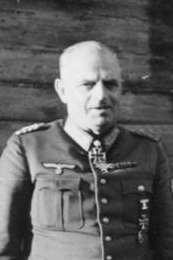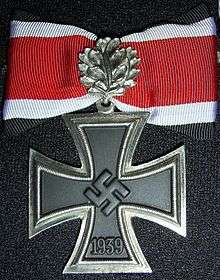Ernst Busch (field marshal)
| Ernst Busch | |
|---|---|
 Generalfeldmarschall Ernst Busch | |
| Born |
6 July 1885 Near Essen, German Empire |
| Died |
17 July 1945 (aged 60) Camp Aldershot, United Kingdom |
| Buried at | Cannock Chase German war cemetery |
| Allegiance |
|
| Service/branch | Heer |
| Years of service | 1904–45 |
| Rank | Generalfeldmarschall |
| Commands held | 16th Army |
| Battles/wars |
World War II |
| Awards |
Pour le Mérite Knight's Cross of the Iron Cross with Oak Leaves |
Ernst Bernhard Wilhelm Busch (6 July 1885 – 17 July 1945) was a German field marshal during World War II and a recipient of the Knight's Cross of the Iron Cross with Oak Leaves.
World War II
Born in 1885, Busch entered the Prussian Army in 1904 and served during World War I. He was awarded the Pour le Mérite in 1918. After the war, Busch remained in the army reaching divisional level command. Busch served under Wilhelm List during the Invasion of Poland of 1939, and the following year he led the 16th Army during the Western Offensive. He was awarded the Knight's Cross of the Iron Cross by Hitler.
During Operation Barbarossa in September 1941, the 16th Army captured Demyansk before taking part in the siege of Leningrad in positions near from Staraya Russa to Ostashkov. Promoted to field marshal, Busch commanded Army Group Centre in 1943 and 1944. After the destruction of the Army Group Center in the Soviet summer offensive of 1944, Operation Bagration, he was relieved of command in early in July 1944 and replaced by Field Marshal Walter Model.
Busch was recalled in March 1945 when he became head of Army Group Northwest. Along with Kurt Student and his 1st Parachute Army, Busch had the task of trying to halt the advance of Field Marshal Bernard Montgomery's forces into Germany. Busch surrendered to Montgomery on 3 May 1945, and died of heart failure in a prisoner of war camp in England, on 17 July 1945.
Awards
- Iron Cross (1914)
- Knight's Cross of the Royal House Order of Hohenzollern with Swords (14 June 1917)[1]
- Pour le Mérite (4 October 1918)[1]
- Clasp to the Iron Cross (1939)
- Knight's Cross of the Iron Cross with Oak Leaves
- Knight's Cross on 26 May 1940 as General der Infanterie and Commander-in-chief of 16. Armee[2]
- 274th Oak Leaves on 21 August 1943 as Generalfeldmarschall and Commander-in-chief of 16. Armee[2]
- Mentioned 4 times in the Wehrmachtbericht (6 August 1941, 16 September 1941, 21 October 1941 and 28 January 1943)
References
Citations
Bibliography
- Scherzer, Veit (2007). Die Ritterkreuzträger 1939–1945 Die Inhaber des Ritterkreuzes des Eisernen Kreuzes 1939 von Heer, Luftwaffe, Kriegsmarine, Waffen-SS, Volkssturm sowie mit Deutschland verbündeter Streitkräfte nach den Unterlagen des Bundesarchives [The Knight's Cross Bearers 1939–1945 The Holders of the Knight's Cross of the Iron Cross 1939 by Army, Air Force, Navy, Waffen-SS, Volkssturm and Allied Forces with Germany According to the Documents of the Federal Archives] (in German). Jena, Germany: Scherzers Militaer-Verlag. ISBN 978-3-938845-17-2.
- Stahel, David (2015). The Battle for Moscow. Cambridge, UK: Cambridge University Press. ISBN 9781107087606.
- Thomas, Franz; Wegmann, Günter (1993). Die Ritterkreuzträger der Deutschen Wehrmacht 1939–1945 Teil III: Infanterie Band 3: Br–Bu [The Knight's Cross Bearers of the German Wehrmacht 1939–1945 Part III: Infantry Volume 3: Br–Bu] (in German). Osnabrück, Germany: Biblio-Verlag. ISBN 978-3-7648-1734-3.
- Thomas, Franz (1997). Die Eichenlaubträger 1939–1945 Band 1: A–K [The Oak Leaves Bearers 1939–1945 Volume 1: A–K] (in German). Osnabrück, Germany: Biblio-Verlag. ISBN 978-3-7648-2299-6.
| Military offices | ||
|---|---|---|
| Preceded by none |
Commander of 23. Infanterie-Division October 1935 – February 1938 |
Succeeded by General der Infanterie Walter von Brockdorff-Ahlefeldt |
| Preceded by none |
Commander of 16. Armee January, 1940 – 12 October 1943 |
Succeeded by General der Artillerie Christian Hansen |
| Preceded by Generalfeldmarschall Günther von Kluge |
Commander of Heeresgruppe Mitte 12 October 1943 – 28 June 1944 |
Succeeded by Generalfeldmarschall Walter Model |
| Preceded by Generaloberst Johannes Blaskowitz |
Commander of Heeresgruppe H 15 April 1945 – 3 May 1945 |
Succeeded by none |
